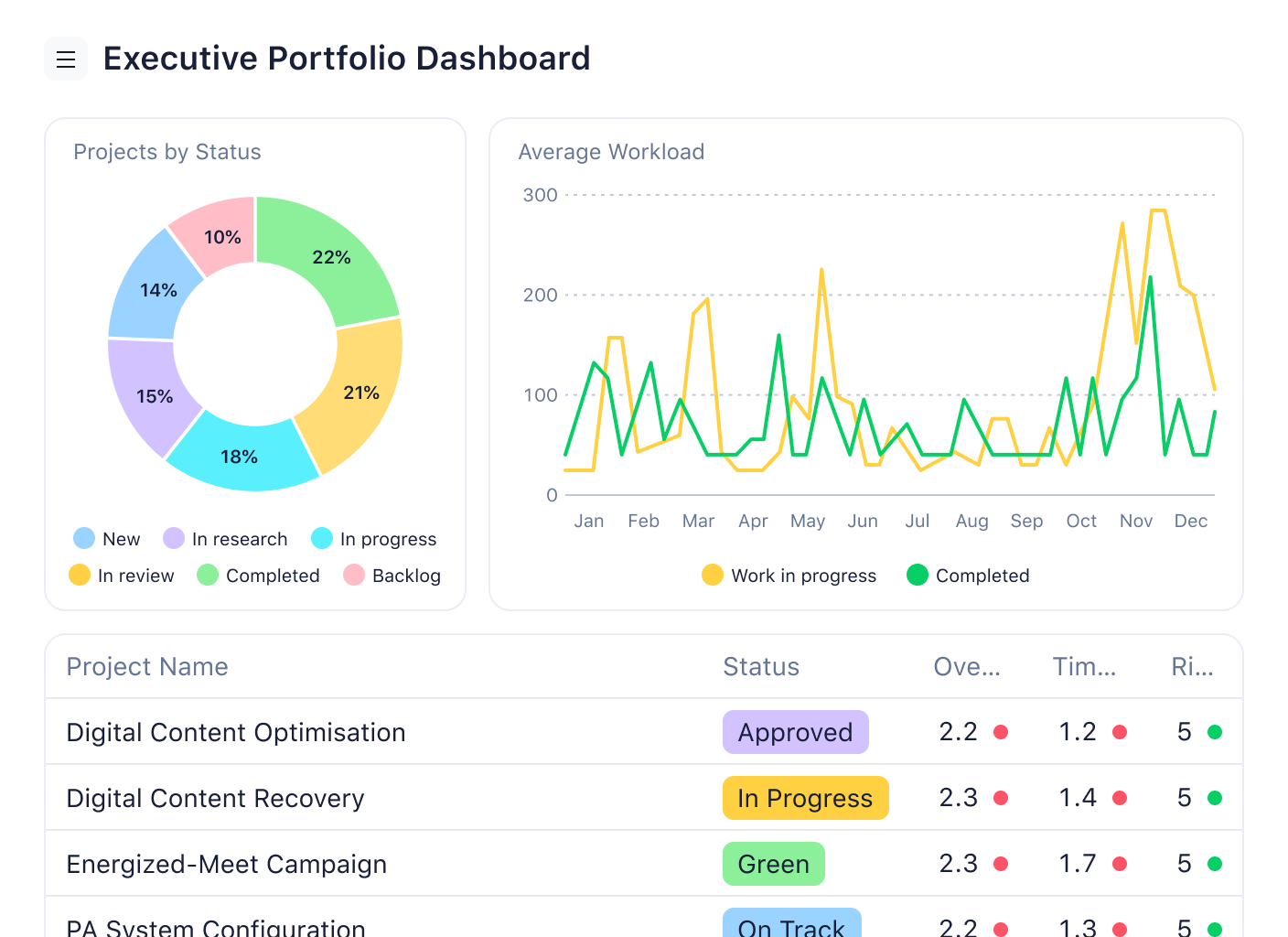Effective marketing involves getting the right message to the right people. That’s why STP marketing is a tool marketers often use to ensure their messaging is directed at the right audience and communicated in a way that entices them to heed a call to action.
So what does STP stand for in marketing? STP in marketing stands for segmentation, targeting, and positioning. These three basic steps dictate how marketers can identify the right customers, serve them the right messaging, and give them the information they need for successful targeting.
In this guide, you’ll discover the concept of STP as a strategic marketing framework, how it works, and why it’s important for creating targeted campaigns to attract valuable customers.
We’ll also show you how work automation software like Wrike can help you implement an STP strategy to stay on top of your marketing campaigns.
STP concept in marketing
Not all customers are the same, so why treat them that way? STP process in marketing makes it easier to tailor your approach so your messaging resonates with the right target audience. Let’s explain the STP process in detail:
Segmentation
First, marketers use marketing analytics to create specific segments of a target audience based on predetermined criteria. The marketing department could choose to segment the audience based on:
- Demographics
- Geography
- Purchasing frequency
- Lifestyle characteristics, like hobbies
- Cultural influences
- Technographics
- Behavioral traits
For example, let’s say you’re selling running shoes. Some of your potential customers might be:
- Professional marathon runners looking for performance-enhancing gear
- Casual joggers who value comfort
- Beginners who want affordable, easy-to-use options
- Parents buying shoes for their sporty kids
Would you use the same marketing messages for all these groups? Of course not. Each group values something different, and market segmentation helps you focus on these differences. This way, you can avoid wasting resources on an audience unlikely to spend money on your product or service.
Targeting
Once you have divided your audience into different segments, you’ll assess those segments. This is necessary in order to determine which segment would be the most profitable to target based on the size of the segment, how willing this segment would be to purchase your product, and how well you’ll be able to reach this segment of the audience with marketing channels available to you.
Not every segment you create will be worth pursuing. To choose the best ones, evaluate each group based on these questions:
- Is the segment large enough and willing to buy?
- Can you reach this group through your marketing channels?
- Does the segment align with your brand and product?
- Are other companies already targeting this segment?
- Will this segment expand over time?
Depending on your goals, you can choose from several targeting approaches:
- Mass marketing: Focuses on the entire customer base with a single message
- Segmented targeting: Targets multiple segments with tailored messages for each
- Niche marketing: Focuses on one specific segment (ideal for smaller businesses)
- Micromarketing: Creates personalized messages for individuals or small groups
When done right, targeting transforms your marketing efforts. Instead of casting a wide net and hoping for the best, you’re engaging the people most likely to connect with your product or service.
Positioning
Finally, positioning involves creating bespoke messaging designed for the segment you’ve chosen to target. This messaging should set your product or service apart from your competitors and push your targeted segment to purchase. Once you’ve determined the target segment, you can create just the right mixture of marketing activities to turn them into customers.
To develop an effective positioning strategy, you need to identify your core strengths. What sets your service apart? Factors include:
- Speed
- Expertise
- Customization
- Affordability
Next, use tools like positioning maps to see where you stand compared to others in the industry. For example, a digital marketing agency might pitch itself as offering mid-priced, high-quality personalized strategies versus competitors providing either low-cost, generic packages or premium services for large corporations.
Once you use the product position map to understand your competitive advantage, you can leverage the marketing 4Ps (product, price, place, and promotion) for execution.
- Product: What do you deliver, and how is it unique?
- Price: How do you compare — premium, affordable, or somewhere in between?
- Place: How accessible are your services (e.g., remote, local, global)?
- Promotion: What messaging will resonate most with your target clients?
A well-crafted positioning strategy differentiates your service and improves the overall customer experience.
Benefits of STP marketing
STP in digital marketing should make tailoring your marketing communications simpler and more effective. Rather than creating generic messaging designed to appeal to large swathes of people, you’re creating personalized messaging that should hopefully appeal to the niche you’ve chosen to focus on. This should result in higher engagement with the target audience and more sales converted in the marketing campaign.
As is the case with many marketing processes, STP in marketing relies heavily on robust marketing analytics to give marketers the ability to create those segments and analyze them accurately. Marketers will need marketing analytics software that can drill down into specific demographic and behavioral details. This will help them create the most effective marketing campaigns.
Creating and executing campaigns requires input from multiple teams. You can use the analytics dashboard in Wrike to visualize key data that reflects your campaign objectives.


STP marketing case studies
How do successful brands know which customers to target? Companies use the STP marketing model daily to shape how they interact with their target audiences. Here are some real-life examples of STP case studies:
Coca-Cola
Coca-Cola doesn’t market itself as a one-size-fits-all product. Instead, it uses the STP approach in marketing to cater to different preferences and lifestyles. Coca-Cola segments its audience based on:
- Lifestyle
- Consumption habits
This is further divided into:
- Calorie-conscious individuals
- Soda lovers
- Flavored water enthusiasts
Coca-Cola markets Diet Coke for those seeking a lighter option, while it markets the original Coca-Cola to customers who prefer a classic, indulgent experience. This allows the company to maintain its global appeal while connecting with individual consumer preferences on a personal level.
Netflix
Netflix uses different STP strategies in advertising to personalize its service and keep users engaged. Netflix segments its audience based on their:
- Viewing habits
- Preferred genres
- Demographics, like age
It then curates personalized recommendations tailored to each user. For example:
- Parents are shown family-friendly titles.
- True-crime enthusiasts are recommended popular documentaries.
- Comedy fans see trending stand-up specials.
This STP strategy in marketing ensures that every user feels like Netflix was designed just for them.
Nike
Nike leverages STP marketing to connect with athletes and casual sportswear enthusiasts alike. The audience is segmented by:
- Sports preferences (e.g., running, basketball)
- Skill levels (casual users vs. professional athletes)
- Lifestyle needs (performance wear vs. casual sneakers)
In terms of positioning, Nike markets itself as a brand that inspires personal achievement through its iconic “Just Do It” messaging.
Manage marketing campaigns in one central place
So, we’ve answered the question, “What is STP marketing?” Now, it’s time to consider how to implement these ideas. Creating a thoughtful marketing strategy is one thing, but executing it effectively is where the real challenge lies. That’s why you should consider bringing all your teams into one central project management platform like Wrike.
Wrike keeps all your team members on the same page. From brainstorming segmentation ideas to finalizing your positioning model, you can centralize conversations, files, and tasks so nothing gets lost in emails or chat threads. You can also use Wrike’s ready-made templates, such as the go-to-market, creative brief, and marketing promotion templates, to organize your campaign from start to finish.


Take the stress out of managing your marketing projects and let Wrike handle the heavy lifting. Start your two-week free trial today.


